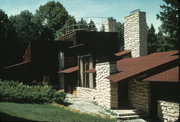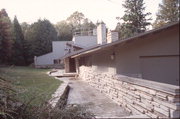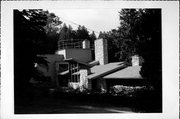Property Record
PENINSULA PLAYER RD, S SIDE, .2 M E OF LAKESHORE
Architecture and History Inventory
| Historic Name: | JACOB R BUCHBINDER HOUSE |
|---|---|
| Other Name: | |
| Contributing: | |
| Reference Number: | 25915 |
| Location (Address): | PENINSULA PLAYER RD, S SIDE, .2 M E OF LAKESHORE |
|---|---|
| County: | Door |
| City: | |
| Township/Village: | Gibraltar |
| Unincorporated Community: | |
| Town: | 30 |
| Range: | 27 |
| Direction: | E |
| Section: | 7 |
| Quarter Section: | NE |
| Quarter/Quarter Section: | SE |
| Year Built: | 1939 |
|---|---|
| Additions: | |
| Survey Date: | 1972 |
| Historic Use: | house |
| Architectural Style: | International Style |
| Structural System: | |
| Wall Material: | Stone - Unspecified |
| Architect: | G F KECK |
| Other Buildings On Site: | |
| Demolished?: | No |
| Demolished Date: |
| National/State Register Listing Name: | Not listed |
|---|---|
| National Register Listing Date: | |
| State Register Listing Date: |
| Additional Information: | A 'site file' exists for this property. It contains additional information such as correspondence, newspaper clippings, or historical information. It is a public record and may be viewed in person at the Wisconsin Historical Society, State Historic Preservation Office. With this house, Keck embraced the principles of Organicism, articulated by Frank Lloyd Wright and others. Nestled into a hillside on its wooded site overlooking Green Bay (a location chosen by renowned landscape architect Jens Jensen), the building seem an intrinsic part of its setting, a character enhanced by the architect’s selected materials. Long slabs of Door County limestone lie in horizontal courses, randomly jutting out of the walls to mimic naturally eroding outcrops. The horizontal slabs contrast with vertical wall planks, made of fir to blend with the surrounding woods. Keck further tied the house to nature by using glass walls and clerestories to offer views of the sky, changing weather formations, and the northern lights. Limestone floors flow out of living spaces to form outdoor terraces; limestone walls continue through the windows into the house. By juxtaposing squares, rectangles, and trapezoids, Keck moved away from the boxy geometry of his earlier designs. These lend the house a rambling, additive appearance. But if the geometric and organic vocabulary suggested a new direction in Keck's work, the passive solar design reflected an interest he had been pursuing at least since 1933 when he unveiled his House of Tomorrow at the Century of Progress exhibition in Chicago. He thereby placed himself at the forefront of passive solar architecture in the United States. In the Buchbinder House, he combined glass walls and clerestories with shed roofs of varying heights to capture sunlight at all times of the year. Using solar energy was then a practice in its infancy, and Buchbinder complained that the abundant sunlight made the principal rooms unlivable during the daytime! He resolved the problem with window coverings. |
|---|---|
| Bibliographic References: | Boyce, Robert. Keck and Keck. NY: Princeton Architectural Press, 1993. Buildings of Wisconsin manuscript. |
| Wisconsin Architecture and History Inventory, State Historic Preservation Office, Wisconsin Historical Society, Madison, Wisconsin |



